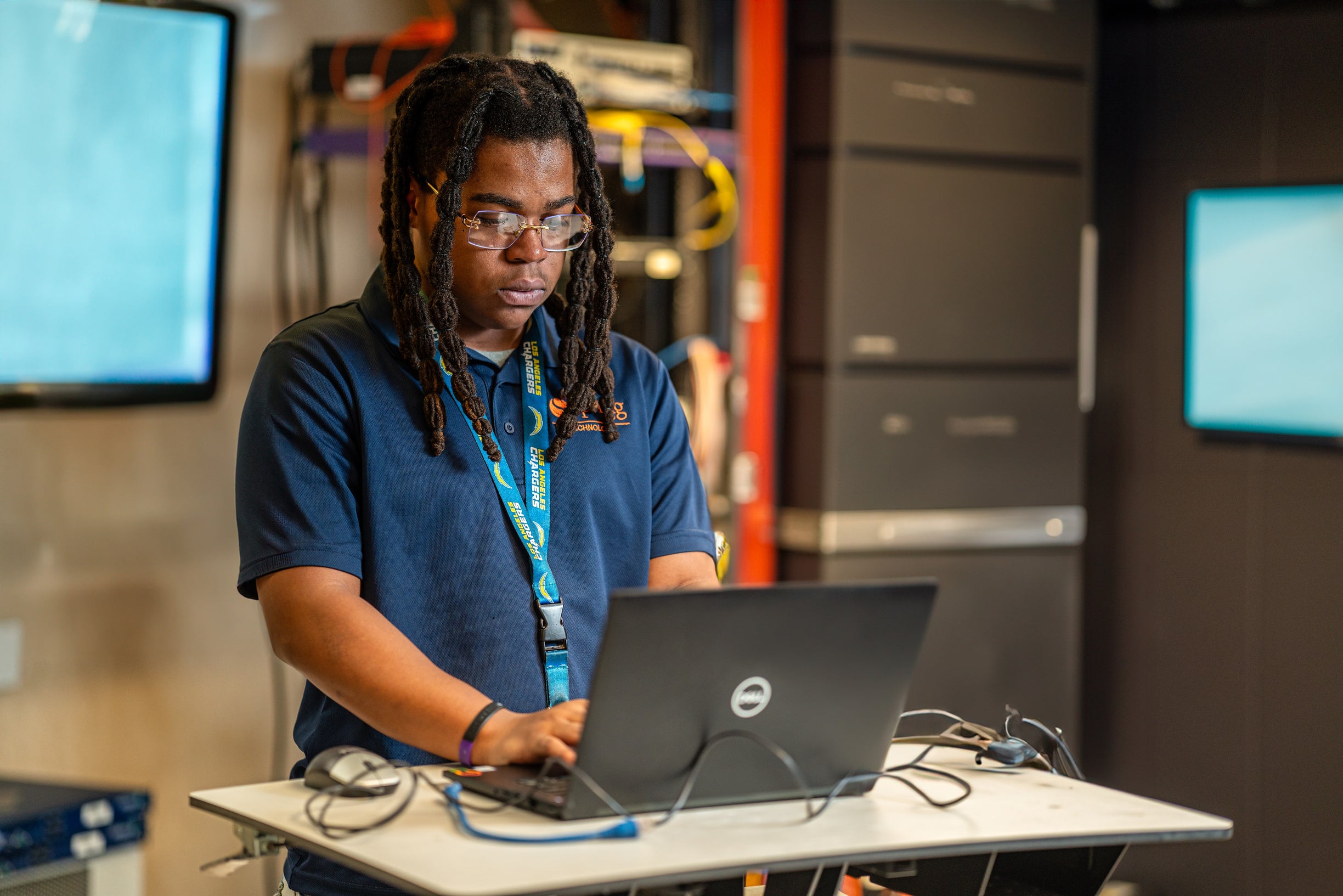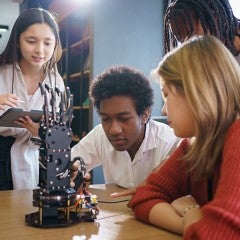King spent most of his high school years at Carl Wunsche Sr. High School, but he wasn’t always sure he wanted to go into technology. At one point, frustrated by a sophomore class in computer programming, he briefly switched his career path to dentistry. But his counselor, together with Wunsche CTE teacher Lisa Evans, helped King see that the field of technology was bigger than he’d imagined.
“It was a computer maintenance class, I’ll never forget that, basically learning about the essentials of the hardware and different components of the computer,” King said. “It changed my whole outlook on how I viewed technology.”
Evans made sure her students got hands-on experience working on computer repairs both at the school’s student help desk and via internship opportunities at Lone Star College. She also made sure they took the steps necessary to complete relevant industry-based certifications, a proactive approach that saves students both time and money after graduation.
“Spring has really built me up,” King said. “They really did give me the opportunity, and they gave me the chance to show what I could do.”
A partnership for growth
Serving over 34,000 students about 20 miles north of central Houston, Spring ISD has experienced significant changes in recent decades thanks to the metro area’s growth. The student body has become more diverse and international, and the district’s footprint has shifted from rural to increasingly urban.
And since 2017, students and alumni like King have reaped the benefits of the district’s partnership with one of the area’s most trusted sources of education data and analysis, the Houston Education Research Consortium (HERC) at Rice University’s Kinder Institute for Urban Research.
In recent years, many districts have expanded CTE offerings to better serve students across a range of career pathways and programs of study. In Spring ISD, CTE updates often reflect the insights gained through its partnership with the Kinder Institute as one of 10 Houston-area districts that share data with HERC’s team of doctoral-level researchers. The consortium’s main goal, according to Associate Director of Regional Research Lizzy Cashiola, is to apply research and data analysis in near real time at a regional scale, generating actionable data to help close achievement gaps and address the complex needs of students, schools, families and employers.
“The ultimate goal is improving outcomes for students, improving equity and access to opportunities — having that shared goal, and using research as a tool to reach that goal,” Cashiola said.

It’s a winning proposition for participating districts, said Spring ISD Chief of Innovation and Student Success Matthew Pariseau.
“We can make great change when it’s led by data,” Pariseau said. “As educators, we’re deeply invested in our students, and we can ‘feel’ a lot of things, but the data shows the reality. When it’s interpreted carefully, it doesn’t lie, and it can help point the way forward.”
Pariseau said entering the partnership with HERC and taking part in the ongoing research, briefings and workshops with other participating districts has been a real benefit, helping district leaders gain a broader perspective and understand the implications of data and trends originally observed at the local level.
“Through all the developments of recent years, they’ve helped us navigate the changing landscape as we seek to innovate and develop programs that best serve the workforce of tomorrow,” Pariseau said.
In recent years, HERC research on student mobility helped Spring ISD and neighboring districts address challenges that arise when students move several times over the course of a school year — both within and between school districts — which include interruptions to their learning and teachers often having to do catch-up work to keep them on track.
“That mobility study helped us really see those gaps, where students were coming to and from, and the need even to have some curriculum collaboration with other districts around us,” Pariseau said. “We have a lot of students that travel back and forth. We saw the gaps within our own data sets from that movement, but the HERC partnership gave us the bigger picture.”
The study helped support Spring ISD’s decision to adopt an aligned curriculum, one that won’t penalize students just because their families move mid-year. Pariseau said the HERC team’s skill in presenting the data also helped campus principals and teachers see the need for the shift.
Designing CTE for student success
In extensive research published in 2023, HERC reviewed the benefits of CTE pathway completion for college, career and military readiness — such as higher initial earnings upon entering the job market — while also noting the challenges many CTE graduates face. Those challenges include trying to complete postsecondary degrees and career certifications while balancing work, family life and other responsibilities after graduating high school.
“The landscape of what CTE is has changed,” Cashiola said. “It’s not just your vocational prep of 10 to 15 years ago. It’s really setting students up for immediately joining the workforce and/or continuing towards a postsecondary credential in an aligned industry.”
According to Pariseau, these insights have bolstered Spring ISD’s commitment to expanding access to dual-credit classes — which are now available to every high school student in the district — as well as supplying more opportunities for students to complete internships and career-related training, and to earn as many industry-based certifications as possible before graduation.
“That’s something that we’ve been working on in Spring, and we’ve had huge growth in that over the last five or six years,” Pariseau said. “We saw that graduates would go through and get the endorsement, but then they weren’t completing the certifications. Now our numbers are much higher, with 70% of our students having at least one industry-based certification by the time they graduate. Also, in all of our high schools, students now have the opportunity for dual credit and an associate degree. That’s not something that was true 10 years ago.”
Cashiola emphasized that HERC is invested in conducting the kind of research that ensures students like King get access to everything they need to achieve long-term success after graduation. She also credited HERC’s partnerships with local districts that have access to real-time data and valuable insights about the challenges educators and students are facing today with making its work possible.
“Data and research tend to lag behind what’s actually happening in schools, and so that’s a challenge,” Cashiola said. “I would absolutely commend Spring ISD for engaging with us in this partnership as thoroughly as they do. … It takes time, effort and many other things to engage in a research study from the beginning all the way to the end. And then they’re the ones that take the information and use it to inform their decisions, so they’re the ones that are doing the hard work to benefit from the partnership.”
While still a student at Wunsche, King was able to complete basic certifications that helped him hit the ground running as an intern and later as an employee in the district’s technology department. Now that he’s a few years into his career and has several roles under his belt — working at the help desk, as an A/V technician and as a campus technology specialist — he has seen the power of certifications and has his sights set on continued learning.
“Within the IT field, it’s nice to have degrees, but the real weight is with your certifications. You need the skills and the certs. I would one day like to be a part of our infrastructure team, so right now I’m studying to get my Network+ certification,” King said.
At just 24 years old, King is coming up on five years with the district, doing work he finds meaningful.
“I’m helping people out, and I guess that’s why I just love this job. … Just seeing what these students are doing and knowing that I play some part in that, it’s so rewarding.”
Michael Esterheld is a communications specialist for Spring ISD.



